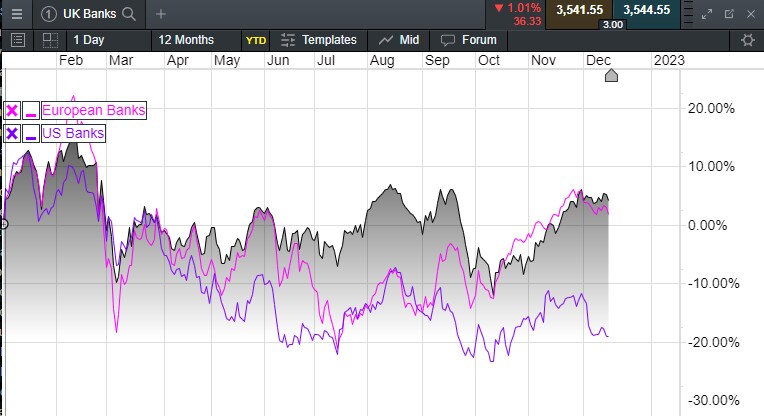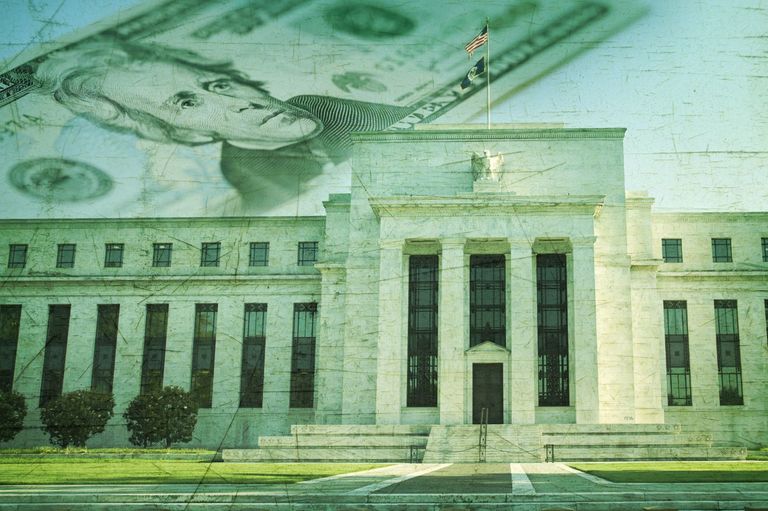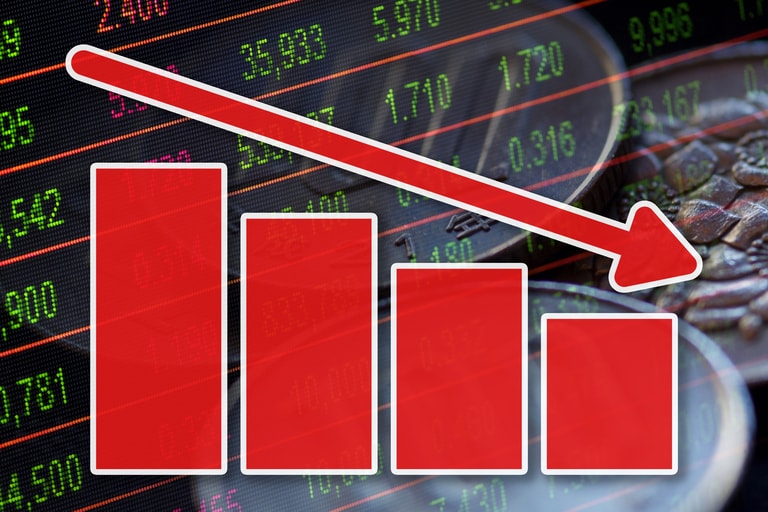While 2021 was a decent year for banks in general, given the record lows we saw in 2020, there was some concern as we headed into 2022 that rising inflationary pressure, while good for bank margins, could well impact consumer borrowing patterns, particularly in mortgage lending which has been quite strong, even as credit card spending remained subdued.
This concern proved to be justified even as central banks initially tried to push back against the tide of calls for more aggressive rate rises, despite rising inflation, as well as inflation expectations.
Even as 2021 was ending it was becoming increasingly evident that the broader economic recovery was showing signs of slowing as winter approached, with consumers facing higher food and energy costs, not only in the UK, but in the US and Europe as well, and central bankers being urged to put aside the groupthink that these rising inflationary pressures were transitory.
Of course, as we now know, these inflation pressures have turned out to be anything but, even without the Russian invasion of Ukraine, which turbocharged them even further.
This surge in inflation, as well as consumers ability to absorb the rising cost of living, was always likely to dictate whether we would see the banks maintain their current positive momentum, improve their profit margins and continue to pay decent dividends.
The Russian invasion of Ukraine served to upend all of that, and while governments once again looked to step in the mitigate the rising costs of energy, prices were already well above trend even before 24 February when Russian tanks entered Ukraine.
Somewhat surprisingly, despite the conflict being fought on Europe’s borders, the worst performing region this year has been the US banking sector, despite the US having the strongest economy.
Comparison: UK, US, and EU banking basket

Source: CMC Markets
The US underperformance probably has more to do with the fact that US banks saw huge amounts of outperformance from their 2020 lows, rising much faster due to huge buyback programs and increased payouts to shareholders. The withdrawal of these measures has seen valuations reset to more realistic levels, and resulted in bigger declines through the current year.
This year has also seen banks here in the UK, as well as Europe, start to set aside further amounts in respect of possible loan defaults, as the cost-of-living crisis bites, and banking systems once again come under strain from spiralling inflationary pressure.
In some parts of Europe, we’ve seen CPI inflation rates of over 20%, while factory gate prices have risen by over 50% in core economies like Germany and Italy.
This year has also been marked by a sharp slowdown in M&A, SPAC and IPO fees which were a feature of 2021 as the air hisses out of the some of the frothier parts of the market.
Investment banking revenues which were also a key factor in the rebound in bank share prices in 2021 have also been more subdued. What has been notable is that despite the greater challenges facing the European economy, European bank valuations have held up relatively well, despite some of the various legacy issues that have faced Italian banks as yet unresolved.
UK banking headwinds
When you consider what UK Banks have had to contend with this year the fact, we’ve seen any gains at all is surprising, but when you look on a slighter longer time frame the case can also be made that the likes of Lloyds and NatWest Group are still seriously undervalued.
Nonetheless while the performance year to date has been disappointing, the numbers that we’ve seen come from the likes of Lloyds and NatWest have been encouraging despite their more domestic focus when compared to Barclays and HSBC, which have other revenue streams from their investment banking divisions.
UK Banks performance YTD

Source: CMC Markets
As can be seen from the chart above the best performers have been Standard Chartered, followed by HSBC, while the more domestically focused banks of NatWest Group and Lloyds have struggled. Barclays, on the other hand has had a shocker, being by far the worst performer of them all.
NatWest Group
After a solid performance during 2021 which saw the shares rise over 40% and be the best performer in the sector, 2022 has been a year of consolidation, for what has been the perennial ugly duckling of the UK banking sector.
In August the shares managed to retest the December 2019 peaks, however they haven’t managed to kick on as much as expected largely due to concerns about the health of the UK economy against a backdrop of rising inflation, as well as rising interest rates.
CEO Alison Rose has done a decent job of giving the bank a makeover and polished up the paintwork; with the bank posting its best set of full year numbers since the financial crisis at the start of the year.
Total profits for last year came in at £2.95bn, although these were boosted by the release of loan loss reserves of £1.28bn. The bank also resumed the dividend declaring a final dividend of 7.5p per share, as well as following through on its promise to buy back £750m of its own shares in the first half of the new fiscal year, while the UK government reduced its stake in the bailed-out bank to 48.1%.
In the first half of this year NatWest was able to shake off the effects of the Russian invasion of Ukraine and concerns about rising energy costs, improving its net interest margins as well as seeing attributable profit to shareholders rise to £1.89bn.
Net interest margins also improved from 2.46% in Q1 to 2.72% in Q2, taking H1 NIM to 2.59%. Net loans to customers rose to £188.7bn, from £184.7bn in Q1, and up by £6.5bn in the first half of the year. £5.9bn of this was by way of mortgages, with lending evenly split between Q1 and Q2, with the remaining £600m being made up of credit card and loan balances.
This resilience helped push the shares back to levels last seen in December 2019 in August, along with the payment of a special dividend, however the shares have come under pressure since then on a combination of concerns over a slowing economy, as well as misguided calls for further increases in taxes on the sector.
The UK banking sector already pays an 8% surcharge in top of a corporation tax rate of 19%, which will increase to 25% next year, putting an effective tax rate of 33% on the sector.
The Q3 numbers were a disappointment and do account, to some extent to the underperformance of the shares since the August peaks.
The bank posted a sharp drop in Q3 attributable profits to £187m, a sharp drop from the £1bn profit in Q2, although this was largely due to one-off factors. The main reason for the profits slide was due to a loss of €652m on the discontinued Ulster Bank operations and the reclassification of the mortgage book, so this is very much a one-off.
When all of this is stripped out the underlying performance was slightly weaker than Q2 as operating profits came in at £1.09bn, slightly shy of expectations, and a £310m fall from Q2. The higher interest rate environment has seen net interest margin increase in Q3 to 2.99%, bringing NIM year to date up to 2.73% from 2.59% in H1.
It was notable the NatWest also increased its impairments in Q3, by £247m, compared to just £26m in H1. Operating expenses also saw a sharp increase in Q2, to just shy of £1.9bn, although they are still lower from a year ago.
On the outlook NatWest said they expect total income to be around £12.8bn with NIM expected to rise to 2.8% by year end, which is all so far so good, however Q4 is likely to be challenging in terms of loan loss provisions, and a general slowdown in the wider economy, which could see a slowdown in its lending, particularly in mortgages where interest rates have jumped sharply higher.
Barclays
Barclays has had a shocker this year, its share price down over 20%, having seen the shares hit their highest levels since 2018 in mid-January, sentiment has soured quite sharply. With a new CEO in place, CS Venkatakrishnan, or Venkat as he is known, hopes were high that he would carry on where previous CEO Jes Staley left off, after a year that saw annual profits rise to £8.4bn, on revenues of £21.9bn.
The honeymoon for Venkat didn’t last long with the bank undergoing a difficult Q1, with his competence called into question after it was revealed that the bank was facing a multimillion US dollar hit and a regulatory investigation over some of its trading products in the US, when he was in charge of controlling the banks risk environment. The mistake appears to have come about after it was realised that the bank sold nearly £28bn of exchange traded notes that track commodity prices over a three-year period and only registered £16bn of them with the SEC.
When the bank announced its Q1 numbers the sum of £540m was set aside in respect of that. Putting that to one side the wider numbers for Q1 did show a bank that was trading well, with total revenues rising by 10% to £6.5bn.
Offsetting that improvement its notable that costs have risen faster, rising 15% to £4.1bn, however £523m of that increase was in respect of litigation costs related to the above. This resulted in an 18% decline in attributable profit of £1.4bn.
When the bank reported in July the numbers were equally underwhelming with charges increased to £600m in H1. Attributable profit for H1 was also down sharply from a year ago due to a big drop in revenues in its equity and debt capital markets division.
The UK bank saw a 16% fall in H1 profits from a year ago to £854m, mainly due to last year’s numbers receiving a boost from a loan loss release, while this year included a £48m set aside for loan loss provisions.
On the wider numbers, Barclays is battling against rising operating expenses for this year, and which rose by 14% in Q3 to £3.94bn, and which are expected to rise sharply to £16.7bn, on an annualised basis, well above the previous outlook of £15bn. Year to date Barclays profits are down 19% largely down to the fact that last year saw profits boosted by the release of loan loss provisions which flattered the numbers.
When Lloyds reported its full year numbers back in February profits came in at £6.9bn, slightly below expectations of £7.2bn. The end of year shortfall was down to a surprise increase in operating costs which rose above £2bn in Q4, up from £1.87bn in Q3, which sent the shares falling to one-year lows, though most of this decline was probably down to concerns over Russia’s invasion of Ukraine.
Nonetheless the bank got off to a strong start to the year with Q1 statutory pre-tax profits of £1.6bn, a modest fall from the same quarter last year. One of the reasons for the slight decline was a £177m impairment, compared to a £360m credit which boosted last year’s number. The impairment was in relation to possible impacts related to higher inflation. Q2 statutory pre-tax profits came in at £2bn.
Operating costs also rose modestly from a year ago, to just shy of £2.1 bn, although they were down on Q4. In Q2 these costs increased to £2.15bn with the bank saying it expected to see total costs of £8.8bn for the year.
Net interest margins have continued to improve, they were raised in Q1 and beat expectations in Q2 NIM rising to 2.87% in Q2, while the bank raised its outlook for return on tangible equity to 13%, from 11%.
While there was little evidence of stress in the underlying numbers when it came to loan demand in H1, Q3 saw a slight change of emphasis from Lloyds management.
In Q2 the bank set aside another £200m of impairments, pushing the total net underlying impairment for H1 to £377m.
In their Q3 numbers this number was increased by £668m in a sign that the recent squeeze on customer finances was increasing concern about possible loan losses, pushing impairment provision year to date to over £1bn.
Q3 statutory pre-tax profits fell back to £1.51bn, a 26% decline on the same period last year, although it has been noticeable that Lloyds has continued to improve its NIM returns, rising to 2.98% in Q3, pushing the average year to date up to 2.84%.
It is also noticeable that loan demand has held up well so far with unsecured loans seeing an increase of 4% to £8.8bn, while the open mortgage book saw an increase of 1%. Lending to small business saw a modest decline of 3% to £39.8bn not altogether surprising given the economic backdrop
For the full year Lloyds says it expects NIM to increase from 2.84% to 2.9% with operating costs expected to come in at £8.8bn, up £2.4bn from where they are now.
HSBC
HSBC got off to a solid start to the year, coming off the lows from September last year to hit two-year highs back in February. Since then, the shares have struggled hitting their lowest levels this year back in October, before rebounding to their current levels, and could well finish the year higher.
The Asia focussed bank has faced a number of challenges this year, after posting a decent set of full year numbers when it reported at the end of February. Full year results saw the bank post reported profits before tax of $18.9bn, a decent increase from last year, with the UK based banking unit outperforming with annual profits of $4.8bn, adding another $1.2bn in Q4. The bank’s Asia operations were the main area of profitability with $12.2bn, with the bank announcing a $1bn share buyback as well as an $0.18c a share dividend.
The main factor holding it back was concern over weaker growth prospects in Asia during Q1 and beyond as Chinese markets continued to struggle with Covid lockdowns and the health of the property sector, which saw the bank take a $500m charge.
In its Q1 numbers the bank incurred further credit impairment charges of $600m, as a result of potential negative impacts from the Russia, Ukraine war. The Asia business and the UK business contributed all of the banks’ profits before tax, with Asia adding $2.8bn and the UK $1.2bn. Reported profit after tax came in at $3.4bn, a reduction of $1.1bn on the same quarter last year, with the bank warning that further buybacks were unlikely in the short term due to concerns over the outlook.
When HSBC reported its H1 numbers there were real concerns that the strict lockdowns in Shanghai and other Chinese cities would seriously negatively impact revenues and profits, although the boost to profits was helped by a $1.8bn deferred tax gain.
The Asia business once again outperformed, with reported profits after tax of $6.3bn, during H1, making up the bulk of the $9.2bn total number, while reported revenues for the same period slipped slightly to $25.2bn. Impairments also rose by another $500m, but the bank was more optimistic about the outlook raising its guidance for net interest income for the year.
This optimism turned out to be a little premature when the bank reported its Q3 numbers back in August with revenues and profits falling back sharply. Q3 revenues sank back to $11.6bn, while profits after tax came in at $2.56bn.
This was significantly lower than the numbers in Q2, with profit attributable to shareholders, dropping to $1.9bn, down from $5.77bn in Q2.
Part of the reason for the lower profits was an increase of provisions for non-performing loans of $1.1bn, doubling the amount set aside year to date to $2.2bn.
On the plus side the banks NIM rose in Q3 to 1.57% from 1.35%, helping to push net interest income to beat expectations, however that wasn’t enough to stop the shares from drifting lower over the next few weeks, before finding a base in mid-October in the wake of the UK budget fallout and hopes that China might be looking to plot a path towards an economic reopening.
The shares also got an additional boost at the end of November after it agreed to sell its Canadian operation to Royal Bank of Canada for $10bn in cash. This appears to be the latest example of Asia’s largest bank looking to gravitate towards its core markets in Asia, and in so doing helping to keep its shareholders onside as it looks to boost the resilience of its core operations, as well as improving pay-outs.
In recent years HSBC management have had to tread a careful line between its business in Asia markets, and its dealings with the Chinese government, and its UK operations.
The recent decision to cancel the dividend after pressure from UK regulators did not go down well with Asia shareholders, with the decision to sell its Canadian operations perhaps an arbiter of things to come in respect of its UK operation.
Ping An the banks largest shareholder, has already gone on the record in urging senior management to embark on some form of spin-off, or separation of its Asia assets, and the rest of the bank, which they have so far resisted.
That doesn’t mean it couldn’t still happen, after all the decision to sell the Canada business, along with the departure of CFO Ewen Stevenson, could be indicative of a direction of travel that ultimately leads HSBC to lean towards a separation of its UK business under the First Direct brand sometime in the future.
Banks resilience to face a key test in 2023
The last 12 months have proved to be a challenging environment for the UK banking sector, yet despite this general profitability has held up well, although there have been some notable weak spots, namely Barclays and Lloyds.
The weakness in Barclays share price is easier to understand given it saw one of the strongest rebounds from the 2020 lockdown lows, and has undergone its own set of problems this year.
NatWest has been very much the outperformer over the past two years, with Lloyds Banking Group very much the underperformer. While NatWest was able to retest its pre-pandemic highs Lloyds hasn’t got even close to them. This seems odd given how much more profitable the bank is now than it was 3 years ago.
As we look ahead to 2023 it is clear that while rising interest rates are good for bank margins the flip side is that demand for loans and mortgages is likely to slow. We are already seeing that in lower mortgage approvals, while the banks themselves are starting to batten down the hatches with higher loan loss provisions, as the air starts to come out of the housing market and valuations fall.
With the energy price cap set to rise further next year, consumer budgets are likely to face even tighter constraints, impacting demand for banking services, unless headline CPI starts to fall back sharply from its current levels of 10.7%.
If the Bank of England is right and the UK is about to enter a two-year recession then the banks could find that 2023 is an even more challenging year than 2022 turned out to be.
Disclaimer: CMC Markets is an execution-only service provider. The material (whether or not it states any opinions) is for general information purposes only, and does not take into account your personal circumstances or objectives. Nothing in this material is (or should be considered to be) financial, investment or other advice on which reliance should be placed. No opinion given in the material constitutes a recommendation by CMC Markets or the author that any particular investment, security, transaction or investment strategy is suitable for any specific person. The material has not been prepared in accordance with legal requirements designed to promote the independence of investment research. Although we are not specifically prevented from dealing before providing this material, we do not seek to take advantage of the material prior to its dissemination.







